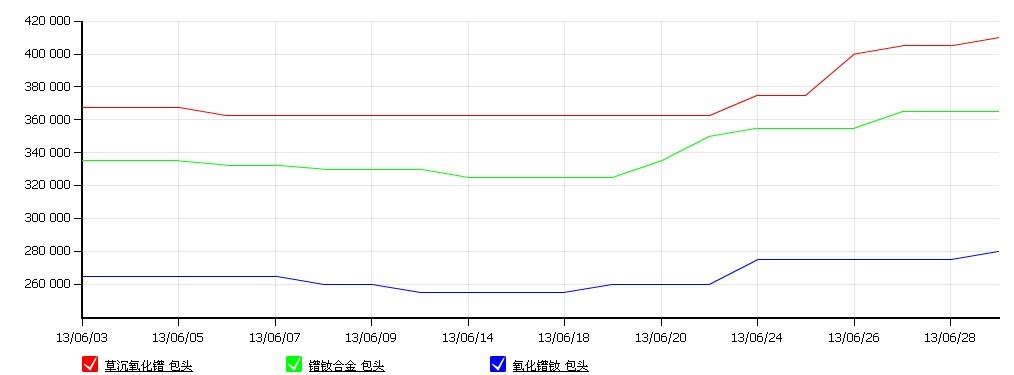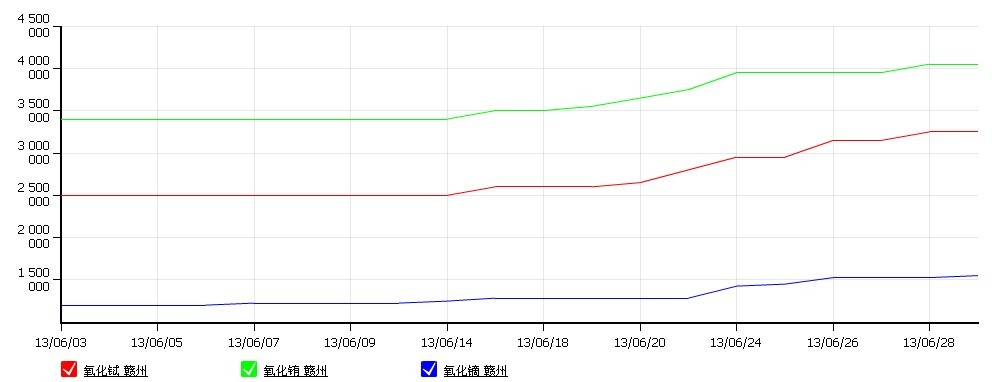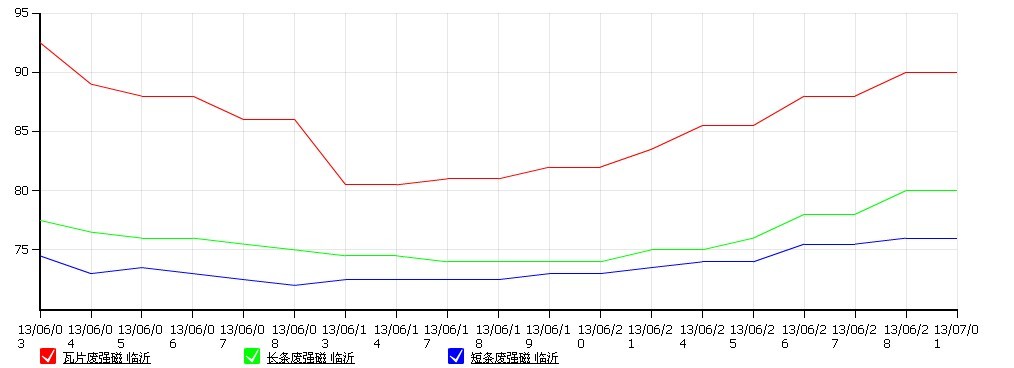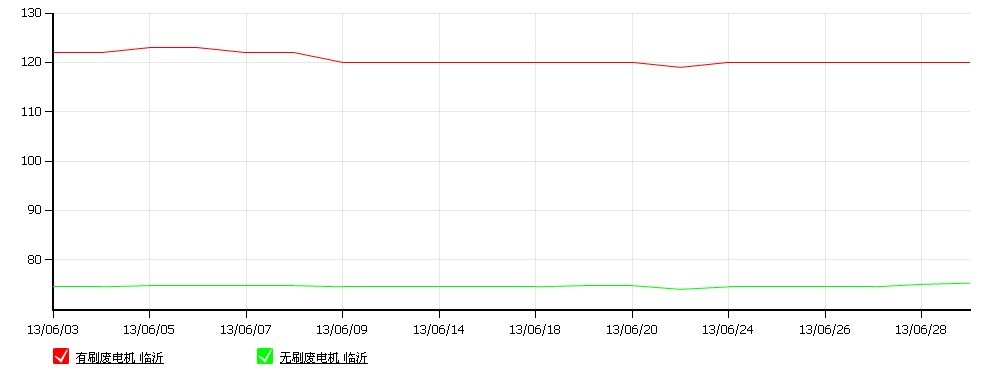Rare Earth Export:
May export volume (tons) | Year-on-year | USD/ton | Year-to-date (tonnes) | |
Rare earth | 1,684 | 72.21 | 22,115.32 | 7,796 |
Rare earth and its products | 3,842 | 8.1 | 47,872.46 | 17,016 |
Industry News:
I. List of enterprises that meet the "Rare Earth Industry Access Conditions" (fourth batch)
Serial number | enterprise | Nature of business | Province (district) |
1 | Suining County Fangxing Rare Earth Co., Ltd. | Mine | Sichuan |
2 | Yiyang Hongyuan Rare Earth Co., Ltd. | Smelting separation | Hunan |
3 | Dandong Jinlong Rare Earth Co., Ltd. | Metal | Liaoning |
4 | Guangxi Hezhou Jinguang Rare Earth New Material Co., Ltd. | Metal | Guangxi |
5 | Gansu Rare Earth New Materials Co. | Metal | Gansu |
Second, Japanese media: Japanese companies will restart the rare earth alloy factory in China
Japanese media said that Japan's Showa Denko is preparing to restart its rare earth alloy plant in China in June. The two factories that were restarted have been essentially suspended since August last year. The restart is mainly due to the signs of recovery of Japanese cars in China, and the demand for rare earth alloys for motors for hybrid vehicles (HV) is expected to pick up. Showa Denko also hopes to maintain personnel employment and production technology in China. Showa Denko is a large-scale professional manufacturer of rare earth and iron alloys of niobium and tantalum. Its alloys produced in factories in Japan and China are sold to various magnet manufacturers.
Showa Electric has restarted two factories in Inner Mongolia and Jiangxi Province. The total production capacity is 4,000 tons, which is equivalent to 4% of the world's overall demand (about 100,000 tons). In addition to supplying to Chinese magnet manufacturers, its products are also exported to Japan. The company said that Japanese magnet manufacturers have begun to increase the purchase of alloy raw materials, but the prospects for demand are not clear. The operating rate of Showa Denko's factories in China may also stay at less than 1% during the year.
Third, scientists succeeded in extracting materials from sand to replace LED bulbs
Compared with incandescent lamps, LED bulbs have the advantages of more energy efficiency and longer service life, but the high price is the key to the popularity among ordinary consumers. The most important reason is the phosphor used in LED tubes. Rare earth elements (REEs) are used. Recently scientists have succeeded in finding alternative raw materials for rare earths and eventually lowering the price of LED bulbs in the future.
LumiSands, a subsidiary of the University of Washington, has successfully developed this alternative material. The LED tubes made with this material are more oriented towards natural sunlight and more cold than existing bulbs. In addition, this material is extracted from cheap and abundant sand.
4. The company is determined to draw a line with the low price of rare earths.
After starting production at the Malaysian plant, Liner could not afford the low prices of rare earths that were currently in vain, especially after experiencing protracted legal proceedings with local and foreign environmental organizations.
The weak demand led Lynas to announce last week that the company will cut costs and wait for demand to pick up before the annual production capacity increases from 11,000 tons to 22,000 tons.
5. Baotou Steel Rare Earth said that it is doing a due diligence on 12 companies to promote the overall restructuring.
In an exclusive interview with Zhang Ruihui, deputy general manager of Baotou Steel Rare Earth, he said that he is currently doing due diligence on the 12 rare earth upstream enterprises that signed the restructuring agreement, and will promote the restructuring of these enterprises in the future. Zhang Rihui said that since 2011, the Inner Mongolia Autonomous Region has reorganized 35 rare earth upstream enterprises, four rare earth enterprises have been eliminated, one rare earth enterprise has been transformed, and 18 rare earth enterprises have been compensated and shut down. Baotou Steel Rare Earth and the remaining 12 The home of rare earth upstream enterprises is integrated and reorganized. This means that Baotou Steel Rare Earth has only one step away from controlling the upstream resources of rare earths in Inner Mongolia Autonomous Region.
Sixth, Luzhou strikes rare earth private mines, the price of rare earths rises
Recently, the Quzhou City Mine Management Bureau organized a large-scale inspection of safety production. The relevant departments carried out a comprehensive crackdown on rare earth private mines, and most private mineral stocks were seized. Affected by this news, some rare earth traders chose to wait and see the market outlook, and the rare earth offer began to increase.
It is reported that the sub-bureau of the Quzhou Municipal Bureau of Mine Management cooperated with the safety supervision department to conduct special inspections on non-coal mine enterprises in the area under its jurisdiction, crack down on all kinds of illegal illegal acts, and strengthen the key rare earth mining areas in the area and the illegal mining of rare earths. Inspection of the patrol. In early June, the county’s rare earth rectification work was held in Xunwu County, a major production area for rare earths in Ganzhou. At the meeting, the company focused on cracking down on illegal mining households using large bulldozers and excavators, operating unlicensed and unlicensed businesses, or operating over-range rare earth production materials, conducting unannounced visits, and conducting weekly inspections, half-month inspections, and January. A notification.
7. Baotou Rare Earth Exchange announced the trading rules in August
The Baotou Rare Earth Products Exchange Co., Ltd., which was established on August 8 last year, has been receiving attention from the market. Recently, Baosteel Rare Earth Secretary Zhang Rihui said in an interview with China Securities Journal that the current rare earth exchange is still in the construction stage. It is expected that the progress will be announced at the "4th China Baotou Rare Earth Industry Forum" held in August this year. Rules.
It is understood that the Rare Earth Exchange was formed by 10 companies each contributing 10 million yuan. Among the 10 companies, there are rare earth enterprises from the northern regions such as Baotou and Gansu, as well as rare earth enterprises from the southern regions such as Guangdong, Sichuan and Xiamen, as well as China's rare earth, Minmetals rare earth and China Nonferrous Metals. Zhang Rihui told reporters that the Rare Earth Exchange has now registered two companies with a registered capital of 120 million yuan.
8. New tungsten and rare earth oxide trading in the South Exchange
On June 17, the Southern Precious Metals Exchange ("South China Exchange") added trading varieties of tungsten rods and rare earth oxides.
According to insiders of the South China Exchange, the average daily turnover of the six trading varieties (silver, indium, bismuth, antimony, bismuth, antimony) of the South Exchange in June reached a maximum of more than 10 billion yuan, of which the daily average of silver The turnover was more than 7 billion yuan. Now that new varieties are on the line, it is expected that the overall daily average turnover will rise sharply. In the follow-up, the South Exchange will continue to improve the trading varieties and strengthen the spot advantage to reduce the transaction costs of the entire industry and promote the development of the real economy. Rare earth oxides have been widely used in petroleum, chemical, metallurgy, Textile, ceramics, glass, permanent magnet materials, etc. With the advancement of technology and continuous breakthrough in application technology, the value of rare earth oxides will become more and more important. .
Nine, the country's first tungsten and rare earth judicial appraisal center was established in Jiangxi
It was learned from relevant departments that, recently, approved by the Jiangxi Provincial Department of Justice, the first provincial-level tungsten and rare earth judicial appraisal institution--"Jiangxi Tungsten and Rare Earth Product Quality Judicial Appraisal Center" was formally established in the National Tungsten and Rare Earth Product Quality Supervision and Inspection Center. The scope of its identification mainly includes tungsten, rare earth and so on. It not only satisfies the demand for litigation of tungsten and rare earth products under the market economy environment, but also provides scientific, authoritative and legally valid appraisal conclusions and basis for the people's courts at all levels to hear cases fairly and impartially.
The establishment of the Judicial Appraisal Center is a corresponding gratifying result with the continuous improvement of the testing and research capabilities of the National Tungsten and Rare Earth Products Quality Supervision and Inspection Center and the continuous improvement of international and domestic visibility. At the same time, its establishment has played a very important role in further expanding the influence and authority of the National Quality Supervision and Inspection Center for Tungsten and Rare Earth Products in the industry. The National Quality Supervision and Inspection Center for Tungsten and Rare Earth Products will also give full play to the positive role of judicial appraisal in serving economic and social development and ensuring the improvement of people's livelihood, and conscientiously fulfilling the management functions of safeguarding judicial justice, safeguarding legitimate rights and interests, and resolving social contradictions. Harmonious development plays a positive and important role.
Market review:

In June, the market continued to be sluggish, and the price trend was relatively flat as a whole, and the decline was significantly smaller than that in April and May. In June, the price of 99.9% of cerium oxide and cerium oxide was basically maintained below 30,000, at around 2.8-2.9 million yuan/ton. Some suppliers slightly adjusted the price, and the adjustment range was around 500-1000 pieces per ton. . The price of base metals continued to decline slightly compared with the previous month, and the lower price at the end of the month fell below 50,000. The current market prices of 镧 and 铈 are at the lowest point in the first half of the year.

The market has performed better in the last two weeks of the month, especially in yttrium oxide, and the price of base metals has risen significantly. In June, the supply of antimony oxide was in short supply, and many merchants indicated that they could not find the goods. At the end of the month, the price of bismuth oxide was increased from 365,000 yuan/ton at the beginning of the month to 410,000 yuan/ton, an increase of 12.3%. Base metals and antimony oxides were stable in the first half of June, and prices remained at the lowest level in the first half of the year. In the last two weeks, market transactions turned better and prices rose steadily. The price of base metal rose by more than 7% from the beginning of the month, and the price of bismuth oxide increased from 260,000 at the beginning of the month to 280,000 yuan/ton, an increase of 7.7%.

Figure 3: 2013.6.1-2013.6.28 price trend of antimony oxide, antimony oxide and antimony oxide (unit: 10,000 yuan/ton)
The prices of antimony, antimony and antimony oxides fell to the bottom in May, and the trend stabilized in the first half of June. In mid-to-late June, prices rose by leaps and bounds. The price of bismuth oxide belt rose from 3.3 million yuan/ton at the beginning of the month to 4.1 million yuan/ton, an increase of 24.2%; the price of bismuth oxide belt rose from 2.4 million yuan/ton at the beginning of the month to 3.3 million yuan/ton, an increase of 37.5%; The price of lanthanum oxide belt increased from 1.15 million yuan/ton to 1.6 million yuan/ton, up 39.1%, the largest increase. At the end of the month, the price of antimony oxides remained relatively firm.

Figure 4: 2013.6.1-2013.6.28 price trend of antimony oxide, antimony oxide and antimony oxide (unit: 10,000 yuan/ton)
In other oxide markets, such as the price trend of é’•é“’é’‡ and other stable transactions, the price of cerium oxide remained low for a long time, the market supply continued to be excessive, and the mainstream transaction price was still below 60,000 yuan/ton. The price of antimony oxide and antimony oxide was flat. At the end of the month, some suppliers increased their prices, and the price rose by about 20,000-30,000.

Figure 5: 2013.6.1-2013.6.28 electric vehicle waste magnetic price trend (unit: yuan / kg)
In June, the volatile magnetic market fluctuated strongly. The recycling price fell to the lowest point of the month in the first half of the year. There were few shipments and receipts in the market, and the transaction was stalemate. In the middle and late period, with the recovery of the rare earth raw materials market, it is willing to accept The number of goods is increasing, and the recycling price has also rebounded remarkably. However, it can be seen from the pictures that although the short and long recovery prices return to the level at the beginning of June, the price of tiles is still low, but in terms of current market recycling demand, Most industry insiders agree that tiles still have some room to rise.

Figure 6: 2013.6.1-2013.6.28 brushless, brushed scrap motor price trend (unit: yuan / month)
In the middle of June, copper prices fluctuated greatly, and the overall price was still down. The scrap motor recyclers slightly reduced the recovery price by 1-2 bucks each in mid-June, but with the rebound of strong magnetic prices, the recovery price remained stable in the brushless. 75 yuan / month, there is a position of 115-125 yuan / brush.
Market outlook:
On July 1st, Baotou Steel Rare Earth announced that its subordinate concentrator will be suspended for half a year, which will bring stronger support to the rare earth market that has already rebounded. At the end of June, the prices of most rare earth products have rebounded. Except for sputum, the contradiction between supply and demand of other rare earth markets has slightly eased. If the market supply continues to tighten in July, the upward trend of rare earth prices will remain. The price of waste magnetics still has a small upside in July, and market transactions will gradually become active as market prices rebound.
Pigments are used for coloring paint, Ink, plastic, fabric, cosmetics, food and other materials. Most pigments used in manufacturing and the visual arts are dry colorants, usually ground into a fine powder. This powder is added to a binder (or vehicle), a relatively neutral or colorless material that suspends the Pigment and gives the paint its adhesion.
A distinction is usually made between a pigment, which is insoluble in its vehicle (resulting in a suspension), and a dye, which either is itself a liquid or is soluble in its vehicle (resulting in a solution). A colorant can act as either a pigment or a dye depending on the vehicle involved. In some cases, a pigment can be manufactured from a dye by precipitating a soluble dye with a metallic salt.
Pigment
China Pigments, Organic Pigment, Inorganic Pigment, Glitter, Pearl Pigment
Dynasty Chemicals (NingBo) Co., Ltd. , http://www.dychemco.com